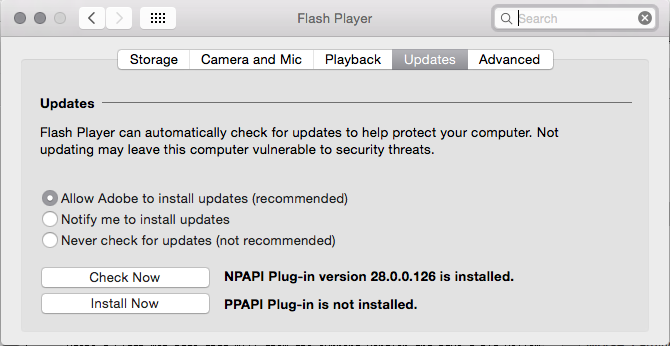

- #INSTALL_FLASH_PLAYER_OSX 1 FOR MAC OS X#
- #INSTALL_FLASH_PLAYER_OSX 1 INSTALL#
- #INSTALL_FLASH_PLAYER_OSX 1 ZIP FILE#
- #INSTALL_FLASH_PLAYER_OSX 1 UPDATE#
- #INSTALL_FLASH_PLAYER_OSX 1 SOFTWARE#
All the files talked about in these methods are downloadable below:įirefox-flash-end-solution-versions.zip_.pdf - Right click on the link and choose “Save Link As” or “Download Linked File As”. If you want to try 32-bit Windows, the files are available, but the functionality has not been tested (although it will probably work).

Windows methods assume 64-bit Operating systems. Here are 3 methods to get Flash running on your favorite website. Further, turning off auto-update in Chrome and Edge is difficult. I am not recommending Chrome or Edge browsers for the below solution because they will auto-update and newer versions will not support Flash at all.

HPE charges money for older CommandView support. So, what can the desperate IT administrator do to manage his or her devices?Īdobe sends users for extended Flash support to a company called Harman. In fact, some of these Flash-managed devices will be there for the next 10 years.
#INSTALL_FLASH_PLAYER_OSX 1 SOFTWARE#
That management software is not going away, even though most of it is older. Some common examples are VMware vSphere, Horizon, and HPE CommandView. However, there are many IT manufacturers out there that used Flash to build their management software interfaces. Yes, I agree with Steve Jobs - Flash is buggy and not secure. Below is the dreaded Flash End of Life logo that you will see once Flash is finally turned off: Apple completely disabled Flash in Safari.
#INSTALL_FLASH_PLAYER_OSX 1 UPDATE#
Microsoft announced they will uninstall Flash from Windows using a Windows Update (although only the Flash that came automatically with Windows, NOT user-installed Flash). Various browser manufacturers announced they will disable Flash. You may have seen plenty of announcements over the past few years about Adobe Flash coming to the end of life.
#INSTALL_FLASH_PLAYER_OSX 1 INSTALL#
This is a quick way to install software on a remote Macintosh or a way to automate installations with scripts.***NOW UPDATED with Apple MacOS instructions, in addition to Microsoft Windows*** ***Also updated with the solution to the mms.cfg file not working due to the UTF-8 bug***
#INSTALL_FLASH_PLAYER_OSX 1 FOR MAC OS X#
Most applications for Mac OS X come in disk images, and many of those have package installers. Hdiutil detach $(df | grep Flash | awk '')
#INSTALL_FLASH_PLAYER_OSX 1 ZIP FILE#
Once it is unmounted, I deleted the zip file and the disk image. I find the volume to unmount by using the “df” command. The better approach is to use the “hdiutil” again. I initially tried using “umount” to unmount the disk image, but that is a bad idea because it doesn’t fully unmount the image. After that, I changed back to the temp directory. It will run through the installation and output some information. installer -verbose -pkg Adobe\ Flash\ Player.pkg -target / Then I used “installer” to install the package specifying the package with “-pkg Adobe\ Flash\ Player.pkg” and the target volume with “-target /”. hdiutil attach Install\ Flash\ Player\ 10\ UB.dmgĬd /Volumes/Install\ Flash\ Player\ 10\ UB/ Next, I used “hdiutil” to mount the disk image and then changed to that directory. Unzip install_flash_player_osx_ub.dmg.zip Then I downloaded the installer and unzipped it. It turns out that the update didn’t work, but I relearned a bit about some useful command line tools for Mac OS X.

She has a PowerMac G4 running Mac OS X 10.4. I decided this was a good opportunity to install the package from the command line over secure shell. My mother needed the latest version of Flash to view a web page.


 0 kommentar(er)
0 kommentar(er)
